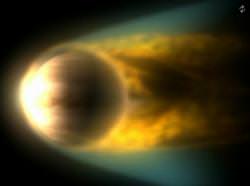It turns out that Venus and Mars aren’t actually that different after all. Although Mars has very little atmosphere to speak of and Venus has a stifling, thick, poisonous one, they have one thing in common: the Sun. The solar wind constantly batters the Solar System’s planets, stripping their atmospheres into space. Is it possible that Mars may once have had a thick atmosphere like Venus’, but has long since leaked away?
The twin ESA spacecraft, Venus Express and Mars Express, have very similar instruments on board and are currently orbiting the two planets. Mars Express arrived on December 25th 2003 and Venus Express arrived on April 11th 2006. Venus Express was intended as a “copy” of the older Mars Express design, but some upgrades were required. Primarily, as Venus is two times closer to the Sun, Venus Express needed better protection from solar radiation. There will also be an increase in ionizing high-energy particles hitting the orbiter, so this had to be taken into account.
Apart from a few minor upgrades, the twin Express missions are able to carry out the same observations on both planets, providing ESA scientists with a unique opportunity to compare results of both spacecraft. In fact, for the first time ever, researchers are able to carry out comparative planetology of two planets with two orbiting spacecraft as they are carrying similar instrumentation.
One such instrument is the Analyser of Space Plasmas and Energetic Atoms (ASPERA) that can be found on both spacecraft. ASPERA has detected atmospheric particles leaking into space as the solar wind hits the planetary atmospheres. Both Mars and Venus, despite their difference in orbits and size, exhibit similar patterns of particle loss. As the planets have no uniform magnetic field surrounding the atmosphere, atmospheric particles are easily swept away. In the case of the Earth, our atmosphere is protected by a strong magnetosphere blanketing us from the ferocious solar wind.
Ultimately ESA scientists hope to analyse the rate of particle loss from Mars and Venus so a better picture of planetary evolution can be arrived at. It is possible that the solar wind may be responsible for the very thin Martian atmosphere. Mars is a tiny planet (only half the size of Earth); whereas Venus is often considered to be Earth’s “sister” as it is approximately the same size. Perhaps the low Mars gravity allowed a higher rate of atmospheric loss than Venus.
What ever the conclusion, mission scientists have a lot of work to do. The results will not only help us understand the development of Mars and Venus, it will also aid our understanding about how the Earth is evolving and may give us some clues to the future.
Video: The strong interaction of the solar wind with the atmosphere of Venus (ESA)
Source: ESA


I wonder what does it take to generate an artificial magnetosphere for a planet like Mars, for maybe Earth for emergencies…
Crash Mercury into it…
Generating an artificial magnetosphere is actually not completely impossible. It would need very large superconducting cables wrapped around the planet on lines of constant latitude, but the stored magnetic energy would be surprisingly modest, on the order of the output of a typical large powerplant for a year or so.
But Venus is more near to the sun, and feels stronger solar wind. it is really amazing that has such a thick atmospher!
We need to pull Venus back from the sun to about where Earth is. Then the planet can cool off and become our fresh start.